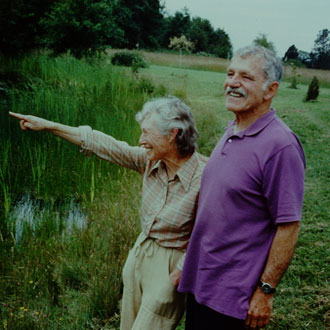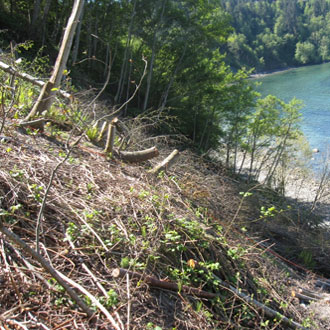Island Dispatch | August 2014
LAND RESTORATION — CONTRADICTION OR CONSERVATION?
When the Preservation Trust acquires a new nature preserve, we begin a long and thoughtful relationship with the land. At times the property is part of a stable ecosystem that requires nothing more than an occasional visit to confirm that all is well. In other cases, however, intervention – in the form of restoration – may be the only way to avoid irreversible damage.
What does “natural” mean? When do we accept that change is natural? And how do humans (more precisely human activity) fit into this discussion? Ecologists engage in endless debate about the role and limitations of restoration, and we at the Preservation Trust fully appreciate the complexity of this issue. In the meantime, the health of the lands we are protecting does not stay static, and neither does our commitment to caring for them.
In some cases, restoration is as simple as removing invasive species so that native species can thrive. As an example, English holly, an aggressively invasive plant, had established itself on our new Mottola Preserve on Lopez Island. After removal of the holly, the native salmonberries and sedges are flourishing in its place.
Another restoration approach we’ve used is to re-introduce or expand threatened or extirpated species. It is estimated that only 1% of historical Garry oak savannah habitat in the San Juan Islands remains intact. Western bluebirds, which were out-competed for dwindling nest sites by non-native birds, completely disappeared from the islands in the 1960’s. Golden paintbrush – an endangered wildflower species that once thrived from Oregon to British Columbia – remains viable on only a handful of sites, including a few in the San Juan Islands. These once prospering species have either disappeared or significantly dwindled in numbers. As a landowner with access to sites where they once thrived, the Preservation Trust is in a unique position to help them survive.
Restoration requires careful planning. Clearing invasive plants opens up bare ground that can be quickly populated by opportunistic species like thistles and non-native grasses, so we intervene by planting native species. On Waldron Island, we are removing young Douglas-fir trees that are competing with old growth Garry oaks and then reseeding the surrounding grasslands. On Vendovi Island, we are removing young firs to re-establish the rare native prairie system that they are displacing.
It doesn’t take long to be humbled by restoration. Removing one native plant (like Douglas-fir) to save others can seem a contradictory concept, and we’ve learned that you can’t pull on one thread without unintended consequences. Yet doing nothing at all is a certain path towards the permanent loss of indigenous island habitat. With a mission to care for the health and future of our island lands in perpetuity, the Preservation Trust is in a unique position to protect some of the diversity that we’ve inherited. You never know: even on the smallest scale, restoration of native species can provide us not only with a window into our past, but also with important – perhaps even essential – options for our grandchildren.
SHE STANDS APART

Of our many cherished donors, volunteers and landowners, a few stand apart. Katherine Mottola, with her husband Mat, donated her first conservation easement – 40 hilltop acres on San Juan Island – to the Preservation Trust in 1987. This gift represented a significant act of faith, as it was only the 10th conservation easement we had ever recorded. After moving to Lopez, Katherine and Mat donated another easement on their new 11-acre wildlife paradise. They were eager volunteers, serving as land stewards and charter members of our legendary Lopez mailing crew, and in 2005, they became our first “Volunteers of the Year”.
Since Mat’s passing in 2009, Katherine’s faith in our work has not wavered. Earlier this year, she donated her Lopez home to the Preservation Trust, reserving a life estate for herself and Mat’s daughter. Upon their passing, the Trust will decide whether to keep the protected property as a nature preserve or sell it with a conservation easement in place, and use the proceeds to protect other important places.
We recently dispatched a Washington Conservation Corps team to Katherine’s property to remove an infestation of English holly. “Look at all of this work,” she admired. “I feel so good about the future of this place now that it is in the Trust’s hands.”
SJPT PREVAILS

The owner of an Anacortes bed & breakfast establishment has agreed to pay a $100,000 settlement to the San Juan Preservation Trust for illegally clear-cutting a portion of an SJPT-owned nature preserve.
The clear-cut property is part of the Preservation Trust’s 1.25-mile long “John H. Geary Shoreline Preserve,” a 38-acre waterfront preserve on the west side of Fidalgo Island. It is presumed that the owner of the bed & breakfast ordered the removal of the trees to enhance the views from his establishment. This action damaged important shoreline wildlife habit and destabilized a steep bank.
The Geary Preserve was permanently conserved in 1992 by a group of neighbors concerned about a proposed development on the property. The Preservation Trust has agreed to drop our pending lawsuit and we intend to use funds from the settlement to restore vegetation, re-stabilize the steep bank, and implement new strategies to avoid future violations.


